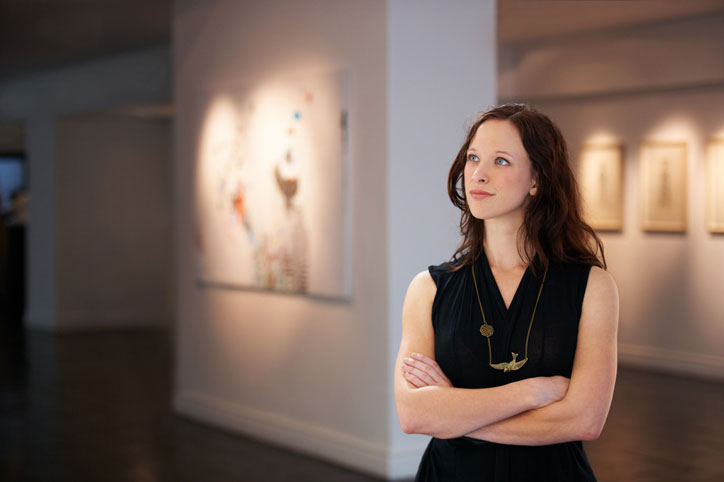

A museum without a curator is just… a building. The Louvre, the Metropolitan Museum of Art, the National Gallery: All just brick and mortar. They’re gorgeous buildings, to be sure, but it takes renowned curators to turn them into the behemoth icons of art that they are.
Curators might not make the art, but they have a strong hand in making the art world.
Characteristically, and guided by enlightening curriculum and unique and expert faculty, liberal arts students have a passionate curiosity and thirst for knowledge. Students attracted to liberal arts programs are often creative and inquisitive by nature.
Donna De Salvo, who served as chief curator at the Whitney Museum of American Art in New York and now curates for the Dia Art Foundation, has said, “I must emphasize, no matter how obvious it sounds, that good curating depends upon a bottomless passion and curiosity for looking and questioning; and the desire to communicate that excitement.”
That, right there, is a spot-on description of a liberal arts graduate.
Curator Job Description – What is a Curator and What Do They Do?
 Curators administer collections and those collections aren’t necessarily art. A curator can specialize in historic items, scientific specimens, music, or even animals. Among other institutions, curators work in museums, galleries, and zoos.
Curators administer collections and those collections aren’t necessarily art. A curator can specialize in historic items, scientific specimens, music, or even animals. Among other institutions, curators work in museums, galleries, and zoos.
Curators do important work in creating accessible and intriguing exhibits that draw in the public–enthusiasts, experts, and laypeople alike–making culturally, historically, and scientifically valuable collections accessible to everyone. These institutions aren’t just interesting places to stroll through on Sunday afternoons, although they are that too. They offer comprehensive and critical looks into areas of our past, our society, and our world.
The nature of the collections may be different, but the duties of a curator remain similar across industry lines. Curators:
- Obtain, store, and maintain collections
- Choose the designs and themes of the exhibits
- Exhibit collections
- Create and implement tours and workshops for the public
- Supervise a curatorial staff
- Occasionally work on special research projects
Curators often double as institution directors, but not always. Curators direct a staff of employees such as museum technicians, who prepare, register, and safeguard collections and help transport, create, and install exhibits, as well as conservators who handle the records of artifacts, specimens, and works of art. Curators hold leadership roles, taking the helm to steer their organization’s offerings in new and often innovative directions. It starts by acquiring the collections. Curators will locate items, negotiate their purchase prices, and authorize sales. They will also facilitate loans and exchanges of collections. Once obtained, they are responsible for storing and managing the maintenance of the items.
Curator positions often involve researching, evaluating, authenticating, and categorizing items in their collections. A curator job, while often keeping you on your feet, will have you sitting at a desk quite a bit to perform administrative tasks too.
Public outreach is a large part of every exhibition venue’s mission. These institutions are, often by definition, a service to society. They’re a place to showcase the heritage of humankind and its environment to all people. Curators are often tasked with designing and leading public education programs and tours to enlighten visitors on the significance of the collections.
Research is not a part of every curator’s job, but many will help to manage their institution’s research projects, which will sometimes include supervising a student staff.
A curator is often the face of an institution. They can find themselves in front of cameras or microphones for the media, or speaking at public events or professional conferences to represent their institutions.
The duties of a curator will vary with the size and type of their organization. Small institutions are more likely to have curators who wear many hats relating to both the collections and the institutional administration, while larger institutions can have a team of curators who each specialize in a particular field and are responsible for distinct collections that come together to make up the whole of the exhibit.
This distinction between types of institutions will also determine how much travel is involved in a curator job. It can range from needing to travel regularly to evaluate potential additions to collections and organize exhibits, to possibly not needing to travel at all if working for a smaller institution.
Curator Jobs Aren’t Limited to Working in a Museum
 While museum, exhibition, and art curator jobs are likely the first that come to mind, curator jobs also serve in some lesser known but exciting capacities. Here are a few curator jobs that you may not have considered.
While museum, exhibition, and art curator jobs are likely the first that come to mind, curator jobs also serve in some lesser known but exciting capacities. Here are a few curator jobs that you may not have considered.
Music curator: A job that entails matching music to brands
Playlist curator: Someone who builds collections of songs for specific listeners or purposes
Content curator: Tasked with gathering and presenting information relevant to a particular subject matter
Animal curator: Curators at research facilities, zoos, animal parks, conservation centers, aquariums, and marine parks who oversee the care of the animals
Costume curator: A person who curates exhibitions of fashion
How to Become a Curator
Curator jobs carry with them a certain amount of prestige in the art world that can intimidate those new to the field, but that doesn’t have to scare you off. Becoming a curator is an attainable goal that provides a variety of paths to a meaningful and interesting career.
“A curator's job does not involve wizardry, but requires a wealth of experience and knowledge, responsibility, and a good overview of artistic developments. But if we are lucky, we curators still manage to enchant visitors with the results.”
~René Block, German curator, collector, and art dealer
To begin moving in the direction of becoming a curator, you’ll first need a master’s degree in your area of expertise. A curator at a museum of history or natural science would need a history or archeology degree, one at an art museum would be well-served by an art history degree, or either would be benefited by a museum studies degree, and so on. However, smaller and newer institutions may be willing to hire curators with bachelor’s degrees.
The well-rounded and interdisciplinary nature of a liberal arts degree lends itself perfectly to a career that is broad by nature. A curator needs to have knowledge on the subject of their collections, yes, but they also need skills in business administration, communication, public relations, marketing, and fundraising. A liberal arts student has the ability to fine-tune their education to fit the specific and balanced needs of their future career.
While earning your master’s degree, serving in internships and taking advantage of volunteer opportunities at museums or other institutions in your community will add value to your candidacy as you begin applying to curator jobs.
Curator Salary – What Curators Can Expect to Earn Doing the Job They Love
The average salary for a curator in the United States is $61,650. Of course, pay will vary greatly depending on the size of an institution’s budget and the level of your expertise. Assistant curator jobs may bring in under $33,000 on the low end of the curator pay range while lead curators at large institutions could be looking at more than $96,000 per year in the highest-paid 10 percent of curator jobs.
Curators are mostly employed by museums, historical sites, colleges and universities, and local and state governments. The highest pay, however, is found in working as a curator for the federal government with an annual average salary of $88,090, followed by grantmaking and giving services with an average of $81,310.
Of course, your passion may not always lie where the most money is. Curators who work for museums, historical sites, or similar institutions earn an average of $58,840 a year.
2020 US Bureau of Labor Statistics salary figures for Curators reflect national data, not school-specific information. Conditions in your area may vary. Data accessed December 2021.






